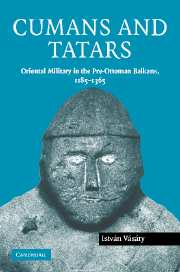Book contents
- Frontmatter
- Contents
- Preface
- 1 Introduction
- 2 Cumans and the Second Bulgarian Empire
- 3 Cumans in the Balkans before the Tatar conquest, 1241
- 4 The first period of Tatar influence in the Balkans, 1242–1282
- 5 The heyday of Tatar influence in the Balkans, 1280–1301
- 6 Cumans and Tatars on the Serbian scene
- 7 Cumans in Byzantine service after the Tatar conquest, 1242–1333
- 8 The Tatars fade away from Bulgaria and Byzantium, 1320–1354
- 9 The emergence of two Romanian principalities in Cumania, 1330, 1364
- Conclusion
- Appendix 1 List of geographical names
- Appendix 2 Chronological table of dynasties
- Appendix 3 Maps
- List of abbreviations
- Bibliography
- Index
Appendix 1 - List of geographical names
Published online by Cambridge University Press: 29 July 2009
- Frontmatter
- Contents
- Preface
- 1 Introduction
- 2 Cumans and the Second Bulgarian Empire
- 3 Cumans in the Balkans before the Tatar conquest, 1241
- 4 The first period of Tatar influence in the Balkans, 1242–1282
- 5 The heyday of Tatar influence in the Balkans, 1280–1301
- 6 Cumans and Tatars on the Serbian scene
- 7 Cumans in Byzantine service after the Tatar conquest, 1242–1333
- 8 The Tatars fade away from Bulgaria and Byzantium, 1320–1354
- 9 The emergence of two Romanian principalities in Cumania, 1330, 1364
- Conclusion
- Appendix 1 List of geographical names
- Appendix 2 Chronological table of dynasties
- Appendix 3 Maps
- List of abbreviations
- Bibliography
- Index
Summary
This list contains only those geographical names that have different forms in different languages. Languages are designated by abbreviations: Bulgarian (Bu), Greek (Gr), Hungarian (Hu), Latin (La), Polish (Po), Romanian (Ro), Russian (Ru), Serbian (Se), Ukrainian (Uk).
Adrianople: Hadrianoupolis (Gr), Drinápoly (Hu), Edirne (Tu)
Agathopolis (Gr), Ahtopol (Bu)
Ainos (Gr), Enez (Tu)
Amaseia (Gr), Amasya (Tu)
Arkadioupolis (Gr), earlier Bergule (Gr), Lüleburgaz (Tu)
Athyras (Gr), Büyük Çekmece (Tu)
Balkans: Haimos (Gr)
Barcaság (Hu), Burzenland (Ge), J̧ara Bîrsei (Ro)
Belgrade: Beograd (Se)
Beroe (Gr), Stara Zagora (Bu)
Bizye (Gr), Vize (Tu)
Braničevo (Se, Bu), Barancs (Hu)
Brassó (Hu), Braşov (Ro), Kronstadt (Ge)
Cracaw: Kraków (Po)
Danube: Istros (Gr), Ister, Danubius (La), Dunav (Bu), Duna (Hu), Dunărea (Ro), Donau (Ge)
Esztergom (Hu), Gran (Ge)
Fogaras (Hu), Făgăraş (Ro)
Gallipoli: Kallioupolis (Gr), Gelibolu (Tu)
Gyulafehérvár (Hu), Alba Iulia (Ro)
Halys (Gr), Kızıl Irmak (Tu)
Haram (Hu), later Palánka (Hu), Bačka Palanka (Se)
Iaşi (Ro), Jászvásár (Hu)
Ikonion (Gr), Iconium (La), Konya (Tu)
Jambol (Bu), Diampolis (Gr)
Kamenča (Bu), Sovolštica (Bu)
Kilia: Chilia (Ro), Kili (Tu)
Konyha (Hu), Cuhea (Ro)
Krassó (Hu), Karaš (Se), Caraş (Ro)
Kučevo (Se), Kucsó (Hu)
Kypsella (Gr), İpsala (Tu)
Lwów (Po), L'vov (Ru), L'viv (Uk), Lemberg (Ge)
Mačva (Se), Macsó (Hu)
Magnesia (Gr), Manisa (Tu)
Maiandros (Gr), Menderes (Tu)
Máramaros (Hu), Maramureş (Ro)
Marica (Bu), Hebros (Gr), Meriç (Tu)
Maros (Hu), Mureş (Ro)
Mesembria (Gr), Nesebăr (Bu)
Miháld (Hu), Mehadia (Ro)
Nagyolaszi (Hu), Franca Villa (La), Mandjelos (Se)
Nikaia (Gr), Nicaea (La), İznik (Tu)
Nikopol (Bu), Nikopolis (Gr), Nikápoly (Hu)
Niš (Se), Naissos, Nisos (Gr)
Ojtoz (Hu), Oituz (Ro)
Plovdiv (Bu), Philippoupolis (Gr)
Rasa (Se), Rascia (La), Rácország (Hu)
Rhaidestos (Gr), Tekirdağ (Tu)
Rousion (Gr), Keşan (Tu)
Šabac (Se), Szabács (Hu)
Saqčï (Ta), Isaccea (Ro)
Selymbria (Gr), Silivri (Tu)
Severin (Bu, Se, Ro), Szörény (Hu)
Silistra (Bu), earlier Drăstăr (Bu)
Sliven (Bu),
[…]
- Type
- Chapter
- Information
- Cumans and TatarsOriental Military in the Pre-Ottoman Balkans, 1185–1365, pp. 168 - 170Publisher: Cambridge University PressPrint publication year: 2005

